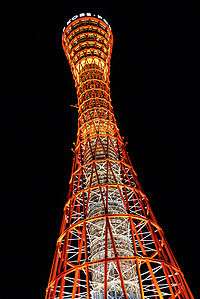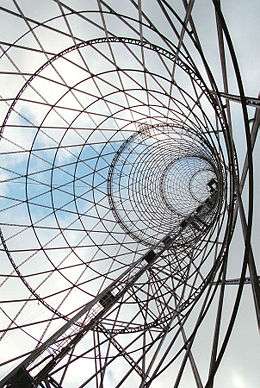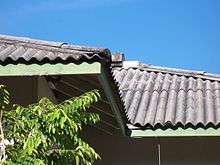Ruled surface

In geometry, a surface S is ruled (also called a scroll) if through every point of S there is a straight line that lies on S. The most familiar examples (illustrated here in three-dimensional Euclidean space) are the plane and the curved surface of a cylinder or cone. Other examples are a conical surface with elliptical directrix, the right conoid, the helicoid, and the tangent developable of a smooth curve in space.
A ruled surface can always be described (at least locally) as the set of points swept by a moving straight line. For example, a cone is formed by keeping one point of a line fixed whilst moving another point along a circle.
A surface is doubly ruled if through every one of its points there are two distinct lines that lie on the surface. The hyperbolic paraboloid and the hyperboloid of one sheet are doubly ruled surfaces. The plane is the only surface which contains at least three distinct lines through each of its points (Fuks & Tabachnikov 2007).
The properties of being ruled or doubly ruled are preserved by projective maps, and therefore are concepts of projective geometry. In algebraic geometry ruled surfaces are sometimes considered to be surfaces in affine or projective space over a field, but they are also sometimes considered as abstract algebraic surfaces without an embedding into affine or projective space, in which case "straight line" is understood to mean an affine or projective line.
Ruled surfaces in differential geometry
Parametric representation

The "moving line" view means that a ruled surface has a parametric representation of the form
where is the generic point on the surface, is a point that traces a curve lying on the surface, and is a unit-length vector that traces a curve on the unit sphere. Thus, for example, if one uses
one obtains a ruled surface that contains the Möbius strip.
Alternatively, a ruled surface can be parametrized as , where and are two non-intersecting curves lying on the surface. In particular, when and move with constant speed along two skew lines, the surface is a hyperbolic paraboloid, or a piece of an hyperboloid of one sheet.
Developable surface
A developable surface is a surface that can be (locally) unrolled onto a flat plane without tearing or stretching it. If a developable surface lies in three-dimensional Euclidean space, and is complete, then it is necessarily ruled, but the converse is not always true. For instance, the cylinder and cone are developable, but the general hyperboloid of one sheet is not. More generally, any developable surface in three dimensions is part of a complete ruled surface, and so itself must be locally ruled. There are developable surfaces embedded in four dimensions which are however not ruled (Hilbert & Cohn-Vossen 1952, pp. 341–342).
Ruled surfaces in algebraic geometry

In algebraic geometry, ruled surfaces were originally defined as projective surfaces in projective space containing a straight line through any given point. This immediately implies that there is a projective line on the surface through any given point, and this condition is now often used as the definition of a ruled surface: ruled surfaces are defined to be abstract projective surfaces satisfying this condition that there is a projective line through any point. This is equivalent to saying that they are birational to the product of a curve and a projective line. Sometimes a ruled surface is defined to be one satisfying the stronger condition that it has a fibration over a curve with fibers that are projective lines. This excludes the projective plane, which has a projective line though every point but cannot be written as such a fibration.
Ruled surfaces appear in the Enriques classification of projective complex surfaces, because every algebraic surface of Kodaira dimension −∞ is a ruled surface (or a projective plane, if one uses the restrictive definition of ruled surface). Every minimal projective ruled surface other than the projective plane is the projective bundle of a 2-dimensional vector bundle over some curve. The ruled surfaces with base curve of genus 0 are the Hirzebruch surfaces.
Ruled surfaces in architecture
Doubly ruled surfaces are the inspiration for curved hyperboloid structures that can be built with a latticework of straight elements, namely:
- Hyperbolic paraboloids, such as saddle roofs.
- Hyperboloids of one sheet, such as cooling towers and some trash bins.
The RM-81 Agena rocket engine employed straight cooling channels that were laid out in a ruled surface to form the throat of the nozzle section.
-

Cooling hyperbolic towers at Didcot Power Station, UK; the surface can be doubly ruled.
-

A hyperboloid Kobe Port Tower, Kobe, Japan, with a double ruling.
-

Hyperboloid water tower, 1896 in Nizhny Novgorod.
-

The gridshell of Shukhov Tower in Moscow, whose sections are doubly ruled.
-
Village church in Selo, Slovenia: both the roof and the wall are ruled surfaces.
-

A hyperbolic paraboloid roof of Warszawa Ochota railway station in Warsaw, Poland.
-

A ruled conical hat.
-

Corrugated roof tiles ruled by parallel lines in one direction, and sinusoidal in the perpendicular direction
See also
- Differential geometry of ruled surfaces
- List of ruled surfaces
- Conoid
- Helicoid
- generalized helicoid
- Rational normal scroll, ruled surface built from two rational normal curves
References
- Barth, Wolf P.; Hulek, Klaus; Peters, Chris A.M.; Van de Ven, Antonius (2004), Compact Complex Surfaces, Ergebnisse der Mathematik und ihrer Grenzgebiete. 3. Folge., 4, Springer-Verlag, Berlin, ISBN 978-3-540-00832-3, MR 2030225
- Beauville, Arnaud (1996), Complex algebraic surfaces, London Mathematical Society Student Texts, 34 (2nd ed.), Cambridge University Press, ISBN 978-0-521-49510-3, MR 1406314
- Edge, W. L. (1931), The Theory of Ruled Surfaces, Cambridge University Press – via Internet Archive. Review: Bulletin of the American Mathematical Society 37 (1931), 791-793, doi:10.1090/S0002-9904-1931-05248-4
- Fuks, D. B.; Tabachnikov, Serge (2007), "16.5 There are no non-planar triply ruled surfaces", Mathematical Omnibus: Thirty Lectures on Classic Mathematics, American Mathematical Society, p. 228, ISBN 9780821843161.
- Hilbert, David; Cohn-Vossen, Stephan (1952), Geometry and the Imagination (2nd ed.), New York: Chelsea, ISBN 978-0-8284-1087-8.
- Iskovskikh, V.A. (2001), "Ruled surface", in Hazewinkel, Michiel, Encyclopedia of Mathematics, Springer, ISBN 978-1-55608-010-4
- Sharp, John (2008), D-Forms: surprising new 3-D forms from flat curved shapes, Tarquin, ISBN 978-1-899618-87-3. Review: Séquin, Carlo H. (2009), Journal of Mathematics and the Arts 3: 229–230, doi:10.1080/17513470903332913
External links
- Ruled surface pictures from the University of Arizona
- Examples of developable surfaces on the Rhino3DE website
